Overview
We assert that an Enterprise Service Bus (ESB) is revolutionizing sectors such as:
- Banking
- Healthcare
- Retail
- Government
- Telecommunications
- Logistics
- Manufacturing
- Energy
- Education
- Insurance
This transformation is driven by our ability to enhance integration and operational efficiency. Each sector experiences significant benefits from the ESB’s capacity to streamline processes, improve data management, and facilitate real-time communication.
Consider the evidence: numerous examples and statistics underscore the positive impact on:
- Transaction processing
- Patient care
- Supply chain coordination
- Claims management
What challenges is your organization facing in achieving seamless integration? We invite you to explore how our ESB solutions can address these issues, driving efficiency and effectiveness across your operations.
Introduction
In today’s rapidly evolving landscape, the integration of technology is not just beneficial; it is essential for operational efficiency and enhanced service delivery. We recognize the Enterprise Service Bus (ESB) as a transformative solution that enables seamless connectivity across disparate systems in sectors such as banking, healthcare, and retail.
By facilitating real-time data exchange and streamlining workflows, we find that ESB not only boosts productivity but also enriches customer experiences. As we strive to adapt to market demands and technological advancements, the role of ESB becomes increasingly vital.
This article explores the multifaceted applications of ESB across various sectors, highlighting its importance in driving efficiency, improving data management, and ultimately shaping the future of business operations.
What’s holding your organization back from embracing this powerful tool? Let’s delve into how ESB can redefine your operational landscape.
ESB in Banking: Enhancing Transaction Processing
In the banking sector, we recognize that an Enterprise Service Bus (ESB) is pivotal in enabling seamless integration among various networks, including core banking applications and payment gateways. By facilitating real-time data exchange, our ESB significantly enhances transaction processing speed and accuracy. For instance, we empower banks to incorporate different payment methods, enabling immediate transaction confirmations and minimizing the chance of errors. This combination not only boosts operational efficiency but also elevates customer experience by providing faster service and reducing wait times.
Our hybrid integration platform, Avato, further enables banks to maximize and extend the value of their legacy infrastructure, simplifying complex integrations and significantly lowering costs. With the capacity to access data and networks in weeks, not months, we ensure that banking institutions can swiftly adapt to changing market needs. The platform also features real-time monitoring and alerts on system performance, which are crucial for maintaining operational excellence. Recent statistics show that 13 percent of consumers have utilized cryptocurrency for goods and services, reflecting a growing trend in digital transactions. As regulatory clarity enhances in the Canadian digital currency market, the necessity for robust unification solutions like Avato’s becomes even more critical. The Bank of Canada’s ongoing research into a potential Central Bank Digital Currency (CBDC) further underscores the changing landscape of banking and the significance of sophisticated unification solutions in adapting to these developments.
The average value of card transactions in the euro area was approximately €39 per transaction in the first half of 2024, highlighting the importance of efficient transaction processing in maintaining a competitive advantage. Banking IT managers have observed that ESB connectivity, especially when enhanced by our platform, provides significant benefits, such as increased transaction speed and precision. As one client noted, “Implementing Avato’s hybrid connection platform has transformed our transaction processing capabilities, enabling us to assist our customers more effectively and swiftly.” Expert opinions affirm that the implementation of an ESB can lead to substantial improvements in transaction processing, allowing banks to streamline operations and ensure 24/7 uptime and reliability. As the banking landscape continues to evolve, the role of our ESB, in conjunction with Avato’s hybrid integration platform, in streamlining transaction processes remains crucial for ensuring operational excellence and customer satisfaction.

ESB in Healthcare: Streamlining Patient Data Management
In the healthcare sector, we recognize that the Enterprise Service Bus (ESB) is pivotal for integrating electronic health records (EHRs), billing systems, and diagnostic tools. By creating a centralized platform for seamless information exchange, we ensure that healthcare providers have immediate access to current patient details—essential for accurate diagnoses and effective treatment. For instance, an ESB example demonstrates how it unifies various healthcare applications, encouraging standardized information formats and improving interoperability. This integration not only enhances workflows but also significantly boosts patient outcomes by alleviating administrative pressures and minimizing the risk of errors.
Utilizing XSLT within the ESB framework allows us to enable effective XML information transformation, substantially reducing the effort required for producing transformative tasks for XML structures. The application of schemas alongside XSLT further enhances this process by identifying programming errors early, resulting in significant cost savings and improved data integrity.
Statistics indicate that the healthcare information unification market is rapidly evolving, with North America leading in 2024, while Asia-Pacific is anticipated to be the fastest-growing region. The integration of EHRs via ESB technologies is expected to enhance patient information management efficiency, as evidenced by case studies showcasing improved operational capabilities within healthcare environments. Notably, breaches from 2009 to 2024 have led to the exposure of protected health information for 846,962,011 individuals, underscoring the critical need for secure data unification in healthcare.
Expert insights reveal that while 70% of healthcare professionals express concerns regarding the swift adoption of AI, we believe that the strategic implementation of ESB can mitigate risks and enhance data management processes. The market for AI-integrated medical imaging is projected to grow at a 26.5% CAGR from 2021 to 2028, indicating a robust trend toward AI adoption in diagnostic imaging. Real-world examples illustrate how organizations utilizing an ESB example have effectively improved their EHR connectivity, ultimately enhancing patient care and operational efficiency. Our hybrid connection platform, Avato, distinguishes itself in this landscape, committed to streamlining complex connections and enhancing the value of legacy technologies, thereby enabling healthcare providers to prioritize delivering exceptional patient care.
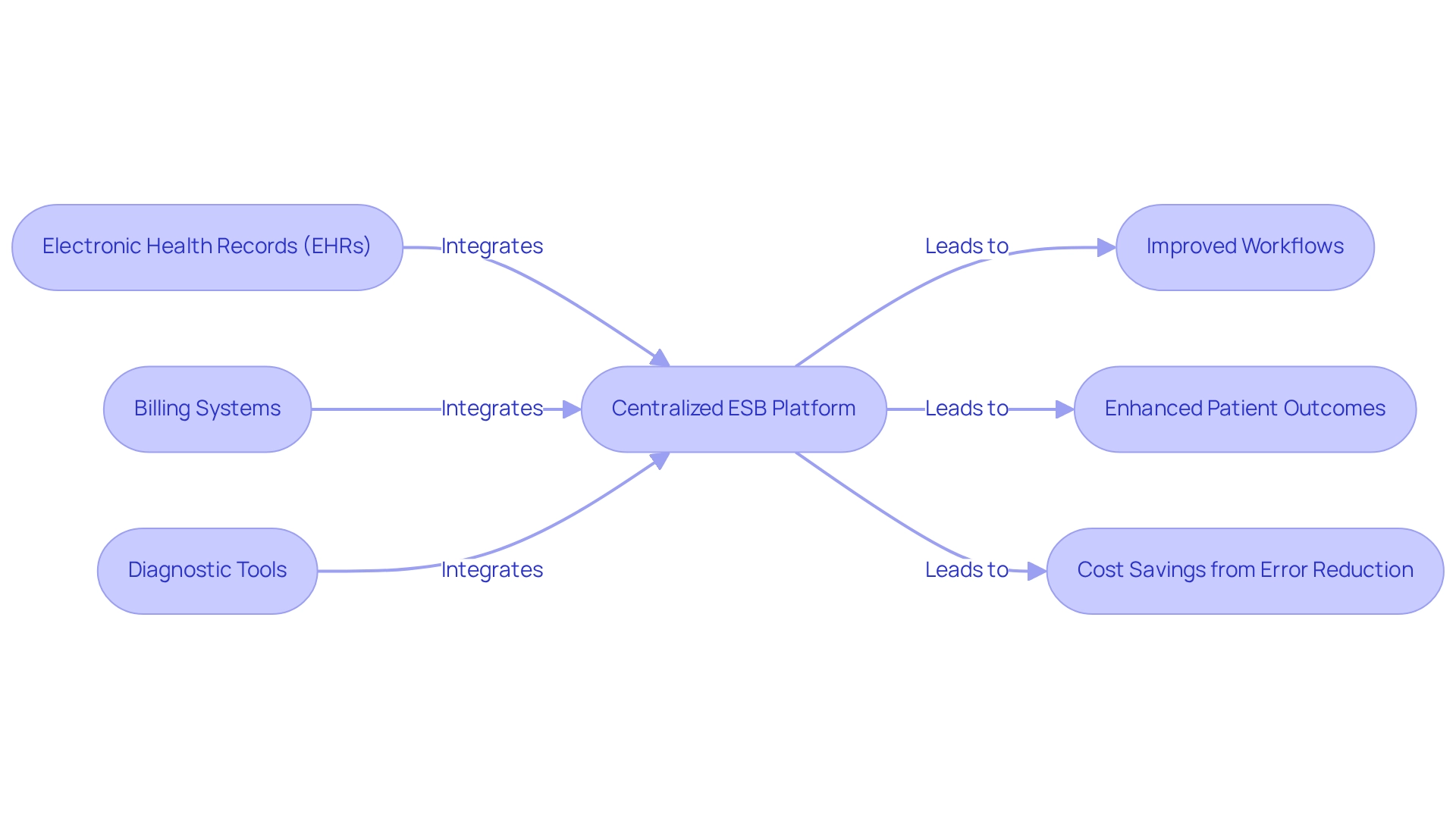
ESB in Retail: Improving Supply Chain Integration
In retail, we recognize that an Enterprise Service Bus (ESB) is pivotal in streamlining supply chain operations by seamlessly integrating inventory management systems, e-commerce platforms, and logistics applications. This integration provides us with real-time insights into stock levels and order statuses, enabling swift responses to customer demands. For instance, a leading retailer implemented an ESB to synchronize inventory data across various channels, which resulted in improved stock accuracy and a significant reduction in out-of-stock situations. This enhancement not only bolstered operational efficiency but also elevated customer satisfaction levels.
Our dedicated hybrid unification platform empowers retailers by simplifying the connection of these disparate systems, allowing businesses to unlock isolated assets and create substantial value. Current statistics indicate that the inventory management software market is projected to reach $2,191.2 million by the end of 2024, reflecting a growing recognition of the importance of effective inventory management solutions. The market is expected to grow at a CAGR of 7.4% from 2024 onward, underscoring the increasing demand for advanced inventory management technologies. Furthermore, approximately 73% of warehouses are planning to implement mobile inventory management solutions, showcasing a shift towards technology that enhances tracking and management efficiency. Combining these mobile solutions with an ESB like ours can further enhance inventory management processes.
Expert opinions underscore the significance of ESB in retail supply chain coordination, with many retail managers noting that this technology considerably boosts inventory management precision. A Gartner survey reveals that Chief Supply Chain Officers (CSCOs) plan to allocate 73% of their supply chain IT budgets to growth and performance enhancements in 2023, indicating a strong focus on improving operational capabilities. As we approach 2025, the emphasis on real-time inventory management connections via ESB is anticipated to become even more crucial, fostering additional advancements in operational capabilities and customer service within the retail sector. Key performance indicators for supply chain optimization, such as cost reduction and inventory turn, will continue to highlight the importance of effective ESB integration, particularly through platforms like ours that are dedicated to enhancing business value.

ESB in Government: Facilitating Inter-Agency Collaboration
In the realm of government, the Enterprise Service Bus (ESB) is indispensable for fostering inter-agency collaboration, enabling seamless data sharing and communication across various departments. Consider this: an ESB can connect platforms utilized by public health, social services, and law enforcement, which is vital for coordinated responses during public health emergencies. This integration not only streamlines operational efficiency but also enhances service delivery to citizens by providing a comprehensive view of available services.
We at Avato, named after the Hungarian word for ‘of dedication,’ exemplify how organizations can simplify the integration of disparate systems through our dedicated hybrid integration platform. This platform unlocks isolated assets and facilitates business value creation, particularly in the banking sector where smooth information connectivity is essential. Statistics indicate that organizations, including the CDC, are modernizing their information practices to enhance access and protection, with a focus on establishing an online repository of resources that promotes advancement in information sharing. By 2025, we anticipate a modern public health information sharing agreement that will further enhance inter-agency collaboration through ESB technologies. This agreement is expected to address existing gaps in information sharing capabilities, especially in local health departments, many of which currently lack the necessary IT infrastructure to engage in genuine bidirectional information exchange, as highlighted by L Michele Issel, Ph.D., R.N.
Real-world ESB examples demonstrate how information sharing has been revolutionized between government departments. Successful initiatives, such as those documented in the case study ‘Moving Forward,’ reveal that improved information practices lead to increased transparency, trust, and health outcomes. Expert insights underscore that the ability to engage in authentic bidirectional information sharing is crucial for local health departments, as many currently lack the requisite IT capabilities.
The advantages of ESB extend beyond operational enhancements; they are vital for public health information exchange among government agencies. By fostering collaboration, ESB not only supports effective responses to health crises but also ensures that agencies can adapt to evolving demands, ultimately resulting in better health outcomes for the community. Our groundbreaking hybrid connection solutions are essential in this process, enabling businesses, particularly in the banking industry, to future-proof their operations through seamless data and network unification.
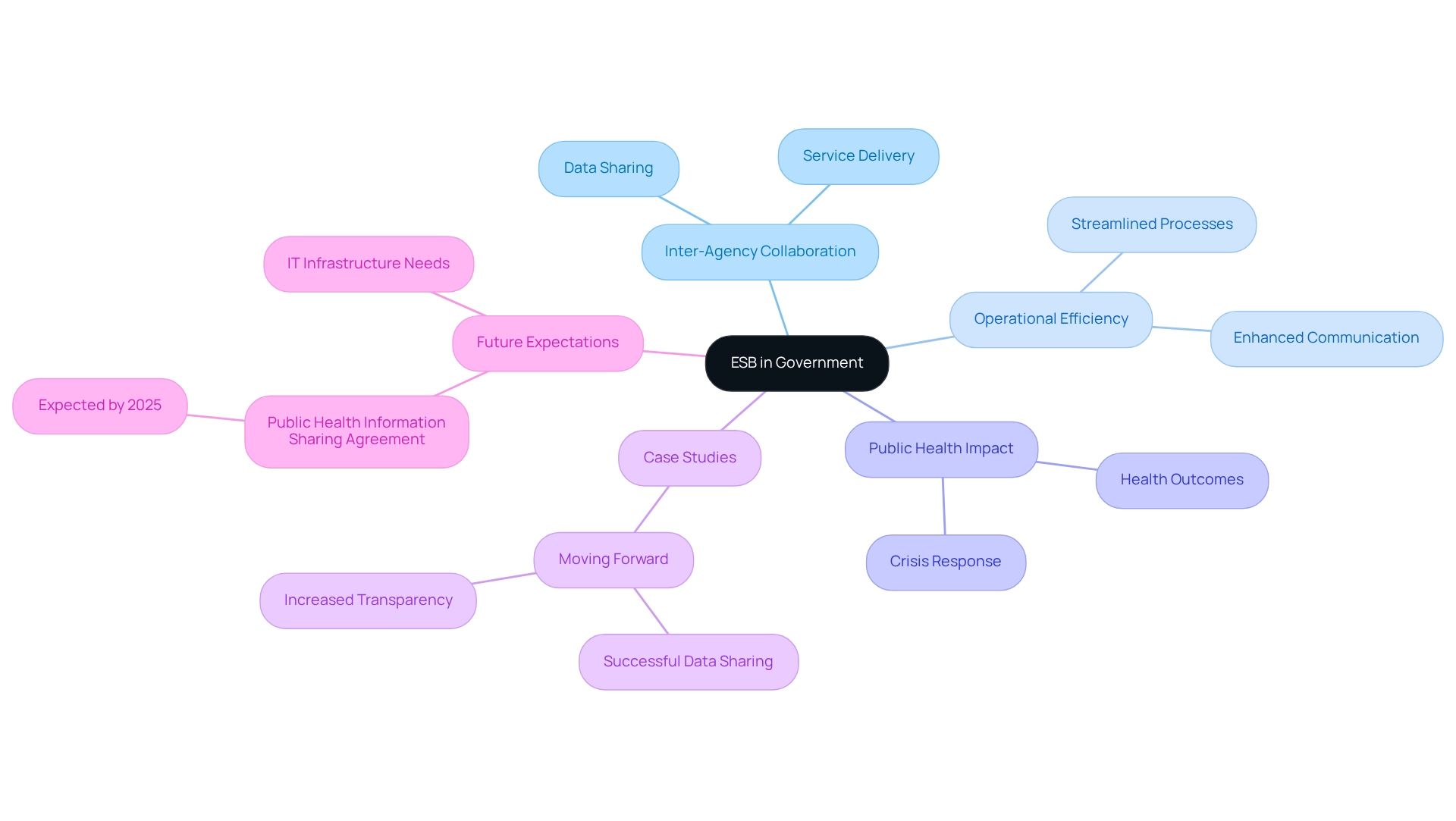
ESB in Telecommunications: Enabling Real-Time Customer Engagement
In telecommunications, we recognize that an Enterprise Service Bus (ESB) is pivotal in enabling real-time customer interaction. By seamlessly connecting customer relationship management (CRM) platforms with billing and service solutions, we empower telecom firms to deliver customized services and respond swiftly to customer inquiries. Consider this: when a customer reaches out to support, an ESB can aggregate relevant data from various systems, allowing our agents to resolve issues more efficiently and significantly enhance overall customer satisfaction.
Recent statistics reveal that organizations utilizing ESB technology in telecommunications have reported a 30% improvement in response times to customer inquiries. This underscores the tangible advantages of this integration. Furthermore, the competitive landscape in the ESB market is intense, with major players consistently introducing new products and services. This reality emphasizes our need to adopt ESB technology to maintain our competitive edge.
Our case studies illustrate how leading telecom providers have leveraged ESB to streamline their operations, resulting in a more cohesive customer experience. It is essential to understand that political and economic factors significantly impact the ESB market, and grasping these dynamics is crucial for us to position our products effectively.
At Avato, established by a dedicated team of enterprise architects, we focus on simplifying complex connections and enhancing operational efficiency. As Gustavo Estrada, Acting Provincial Director at BC Provincial Health Services Authority, noted, “Avato enabled us to align the outcomes we wanted to achieve in the time frame and price point we were targeting.” This perspective reinforces the value of ESB in boosting operational efficiency. Additionally, our hybrid integration platform features real-time monitoring, performance notifications, and the capability to access isolated assets, making it vital for integrating CRM and billing platforms. As the market evolves, the role of ESB in adapting to changing consumer demands becomes increasingly crucial, enabling us to maintain a competitive advantage. We also frequently engage in strategic alliances with ESB suppliers and integrators, demonstrating our commitment to enhancing customer interaction through ESB technology.
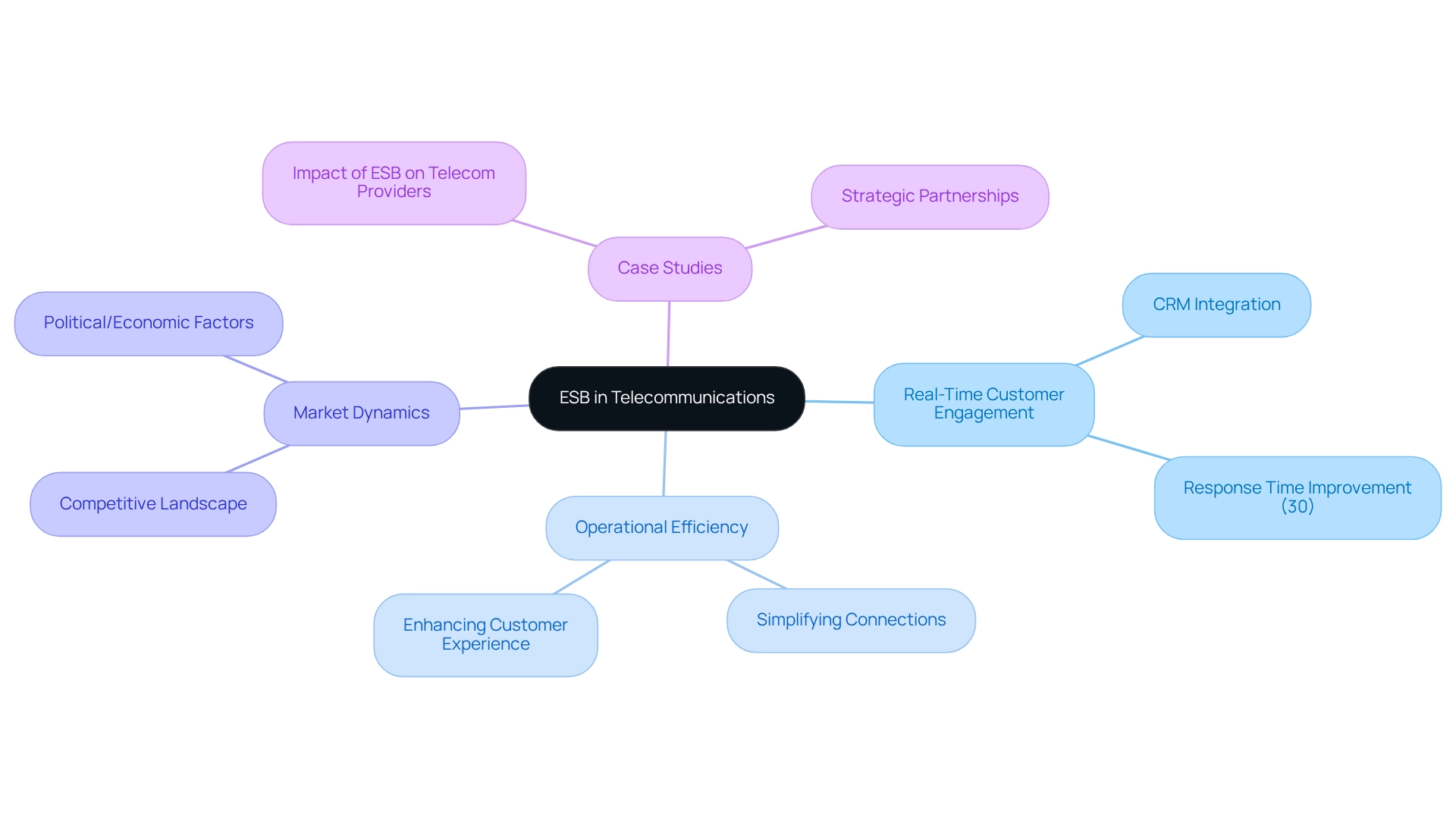
ESB in Logistics: Optimizing Shipment Tracking
In logistics, we recognize that an ESB example significantly enhances shipment tracking by seamlessly integrating various systems, such as Transportation Management Systems (TMS) and Warehouse Management Systems (WMS). This powerful combination empowers us to track shipments in real-time, providing accurate delivery estimates and enhancing communication with our customers. For instance, by leveraging an ESB, we can automatically notify customers about shipment statuses, which not only reduces the volume of inquiries but also builds customer trust.
Recent statistics reveal that organizations are increasingly prioritizing technology investments to streamline operations, with:
- 39% aiming to cut supply chain operational costs in the next two years.
- 31.52% of organizations looking to invest in production and distribution automation, underscoring the growing recognition of technology’s role in enhancing logistics efficiency.
The implementation of ESB technology serves as a pivotal example in achieving these goals, as it facilitates real-time shipment tracking and updates. By 2025, we are witnessing a surge in the adoption of ESB technology for shipment tracking, driven by the need for compliance, collaboration, and operational efficiency. Logistics managers have noted that the real-time tracking capabilities provided by the ESB example lead to enhanced visibility and responsiveness in operations. Expert insights indicate that an ESB optimizes shipment tracking by facilitating real-time communication across various logistics functions, thereby improving overall operational efficiency. Furthermore, the incorporation of XSLT within ESB frameworks enables efficient XML data transformation, reducing programming errors and enhancing data interoperability. This capability is essential for ensuring that our logistics operations can adapt to changing demands and maintain high levels of service. By utilizing Avato’s hybrid connectivity platform, we can further enhance these processes, ensuring a strong connection among diverse systems.
Case studies illustrate how organizations that have embraced ESB technology have experienced substantial advancements in shipment tracking precision and customer satisfaction, highlighting the transformative influence of ESB in logistics operations. The need for skilled IT personnel, as highlighted in the case study on Human Resource Development for IT Adoption in Malaysia, emphasizes the importance of investing in training to effectively implement ESB solutions. Additionally, having a modern ECM is essential for compliance, collaboration, supply chain visibility, and operational efficiency in logistics operations, further reinforcing the value of ESB technology.
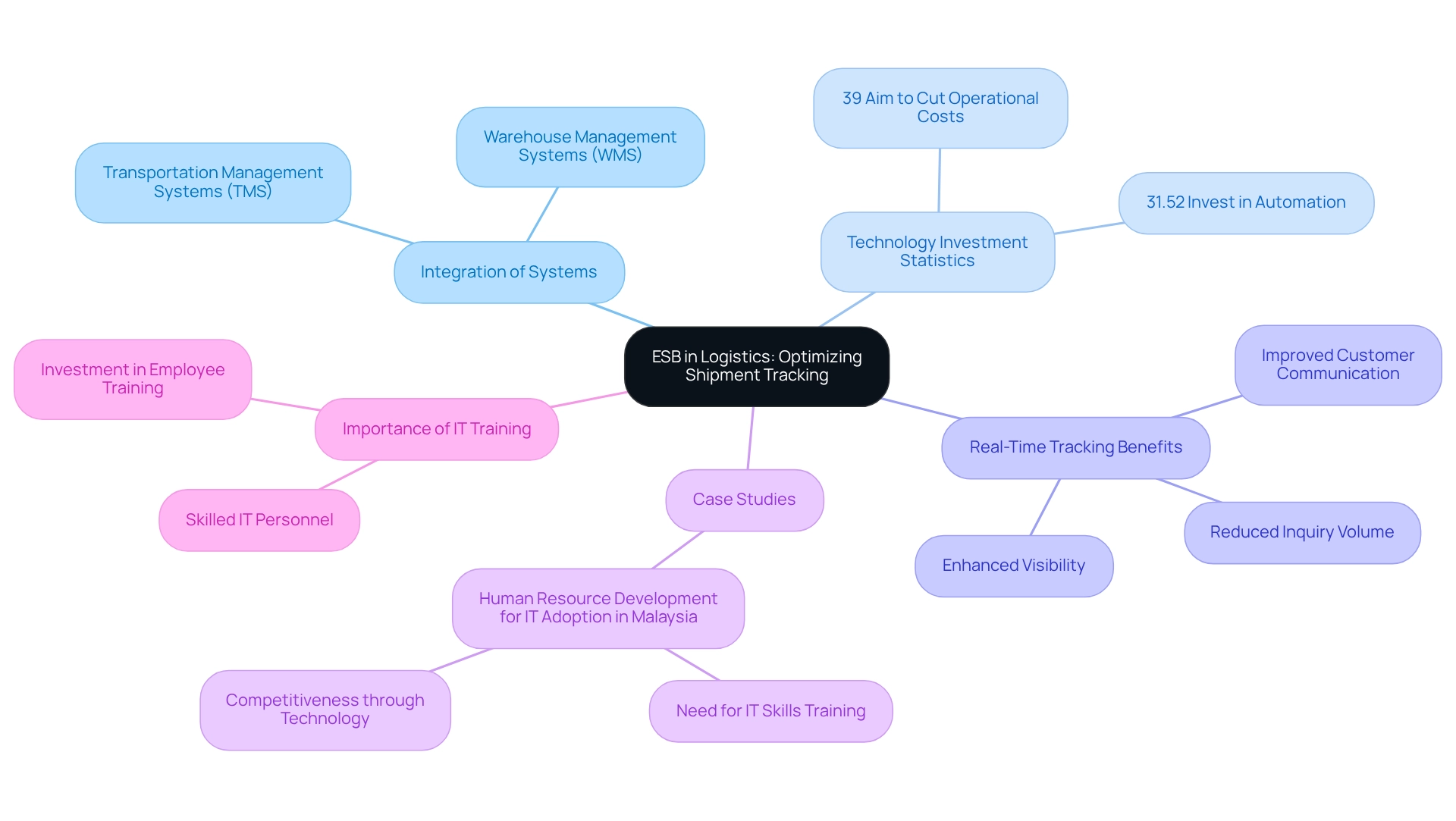
ESB in Manufacturing: Enhancing Production Line Efficiency
In the manufacturing sector, we recognize that an Enterprise Service Bus (ESB) significantly enhances production line efficiency by seamlessly integrating various systems, including:
- enterprise resource planning (ERP)
- manufacturing execution systems (MES)
- supply chain management (SCM) tools
This integration allows for real-time observation of production processes, empowering us to quickly pinpoint bottlenecks and enhance workflows. For instance, a recent implementation of an ESB enabled a manufacturer to connect its MES with ERP, resulting in notable improvements in inventory management and a reduction in production downtime.
Current statistics reveal that organizations leveraging ESB technology have experienced up to a 30% increase in operational efficiency, underscoring the transformative potential of ESB in modern manufacturing environments. As Idowu Koyenikan aptly stated, “If you look at anything successful, you will find traces of a good leader in it.” This sentiment resonates with the guidance we need to execute effective unification strategies.
Our hybrid connection platform exemplifies leadership by providing the necessary tools for manufacturers to link ERP and MES solutions efficiently, ultimately enhancing production capabilities and lowering expenses. By utilizing our specialized hybrid connectivity solutions, we can safeguard operations through smooth data and network unification, ensuring we remain competitive in a constantly changing market.
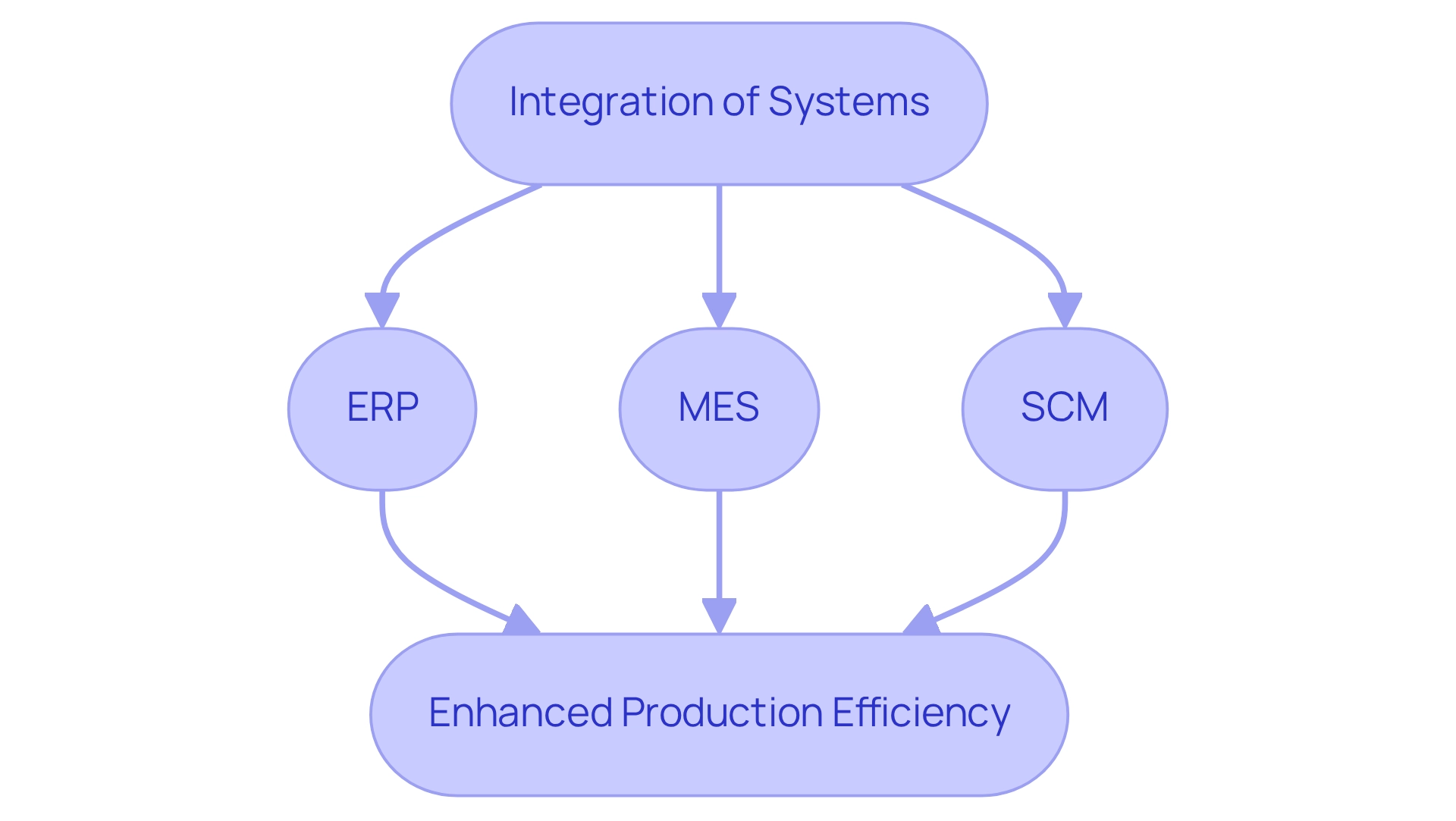
ESB in Energy: Supporting Smart Grid Integration
In the energy sector, we recognize that an Enterprise Service Bus (ESB) is crucial for smart grid unification, seamlessly connecting various networks, including energy management solutions (EMS), distributed energy resources (DER), and customer engagement platforms. This integration empowers us to monitor energy consumption in real-time, optimize energy distribution, and enhance customer interactions. For instance, an ESB can significantly improve communication between smart meters and utility networks, facilitating dynamic pricing models and bolstering demand response capabilities. Recent statistics indicate that energy management systems integrating with IoT can drive substantial efficiency and cost savings, highlighting the importance of ESB in achieving operational excellence.
Gustavo Estrada, one of our clients, remarked, “Avato possesses the capability to streamline intricate projects and provide outcomes within specified timelines and financial limitations,” underscoring the efficiency of our combined solutions in the energy industry. Our commitment to simplifying complex unification challenges is central to Avato’s mission, as we strive to unlock isolated assets and facilitate business value generation through our hybrid unification platform.
Furthermore, insights from the case study titled “Predictive Maintenance with IoT” illustrate how IoT technology enables the anticipation of equipment failures before they occur, allowing for timely repairs and minimizing downtime. This proactive approach results in reduced operational expenses and enhanced overall efficiency.
As the Europe Smart Grid Network Market continues to evolve, the significance of ESB in facilitating smart grid integration becomes increasingly evident. By leveraging ESB architecture, we empower energy providers to achieve greater operational efficiency and responsiveness, ultimately leading to reduced energy costs and improved service delivery. To fully harness the advantages of ESB, we encourage utilities to consider how our unification solutions can enhance their energy management frameworks and adapt effectively to changing energy demands.
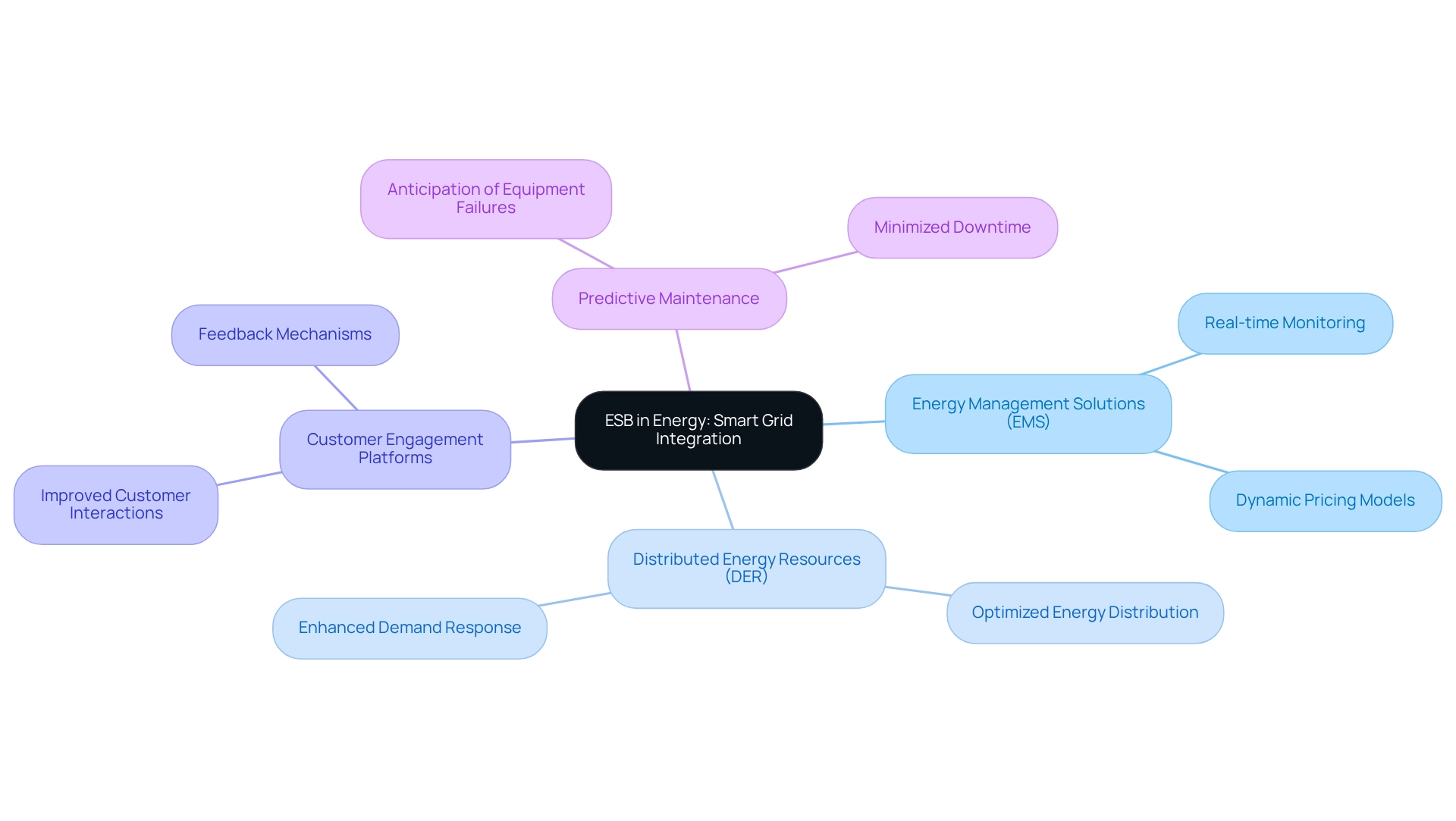
ESB in Education: Improving Data Sharing and Management
In the education field, we recognize that an Enterprise Service Bus (ESB) plays a crucial role in enhancing information sharing and management by seamlessly connecting student information systems (SIS), learning management systems (LMS), and various administrative applications. This integration empowers educational institutions to obtain a comprehensive perspective on student information, which is essential for informed decision-making and fostering personalized learning experiences. For instance, our ESB enables real-time updates of student records across various platforms, ensuring that educators have prompt access to the latest information.
Current statistics reveal that the student information market is divided into on-premises and cloud-based deployment modes, reflecting a rising trend among educational institutions to adopt ESB solutions for improving their management processes. Expert opinions emphasize that implementing an ESB not only enhances operational efficiency but also enriches the overall educational experience by facilitating timely access to critical data. Our ESB example illustrates the effectiveness of integrating SIS and LMS within educational environments. Organizations utilizing our ESB have reported improved accuracy of information and reduced administrative burdens, allowing educators to focus more on instruction rather than information management. A recent case study on the amalgamation of AI and analytics within SIS indicates that 45% of higher education institutions intend to leverage AI and machine learning in their administrative frameworks within two years, underscoring the transformative potential of ESB in modernizing educational information management.
As the educational landscape continues to evolve, the integration capabilities offered by our ESB are becoming essential for institutions striving to remain competitive and responsive to student needs. Moreover, a recent survey identified Magnus as the leading provider for information security and HIPAA compliance among school health record software systems, highlighting the importance of secure connections facilitated by our ESB in educational information management. By incorporating XSLT into these unification processes, we can further enhance the efficiency of XML data transformation, reducing programming errors and streamlining data handling. Our commitment to designing robust connection solutions ensures that educational institutions can effectively utilize these technologies, ultimately leading to improved outcomes for both students and educators.
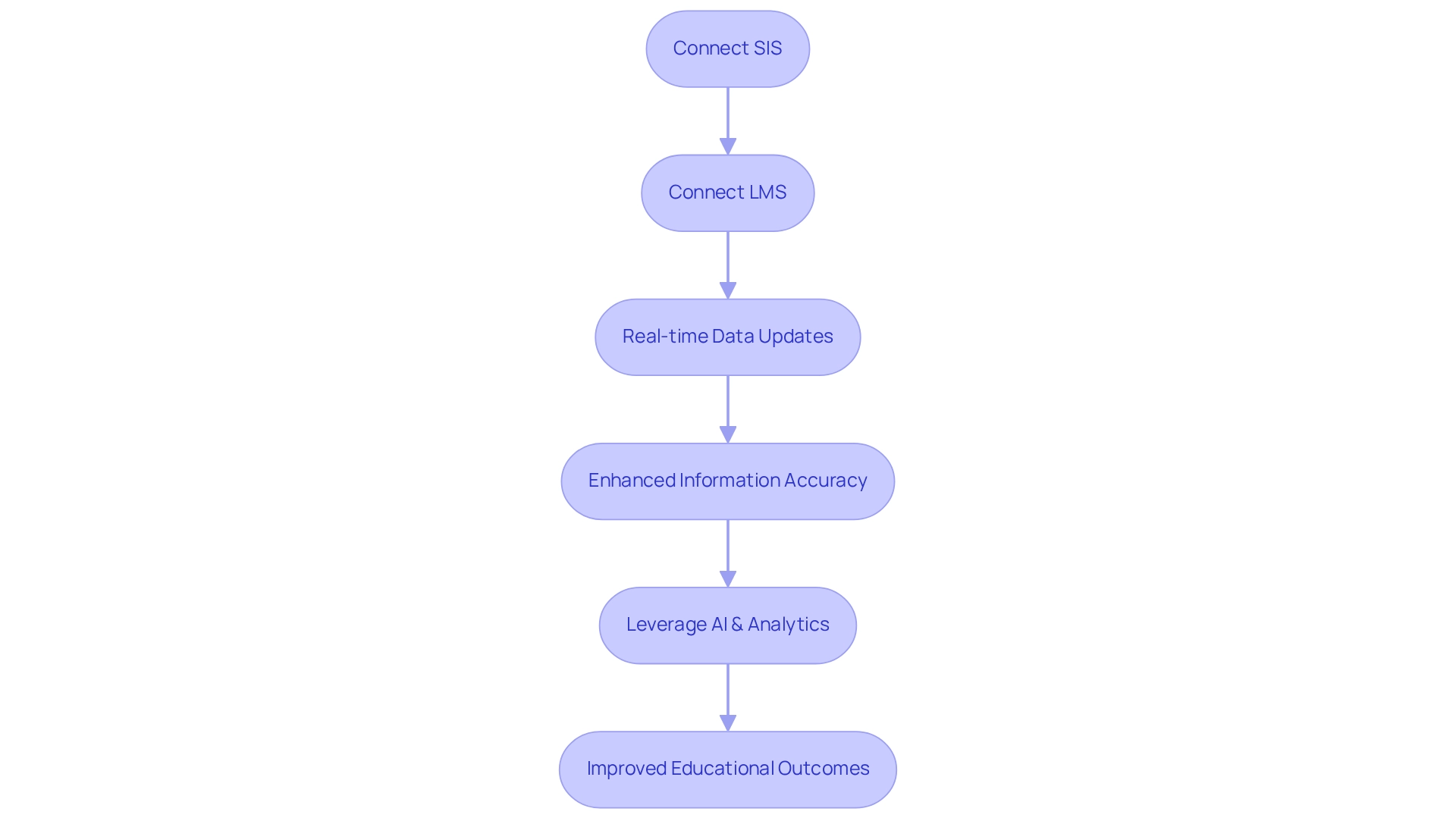
ESB in Insurance: Streamlining Claims Processing
In the insurance sector, we recognize that an ESB example significantly enhances claims processing by seamlessly connecting various platforms, including claims management, underwriting, and customer service. This integration empowers us to automate workflows, drastically reduce processing times, and improve accuracy. For instance, an ESB example enables real-time data transfer between claims adjusters and underwriting platforms, resulting in faster claims resolution and increased customer satisfaction. Moreover, our Hybrid Integration Platform offers real-time oversight and notifications on performance, ensuring that we can proactively manage our operations.
Statistics reveal that insurers employing traditional claims methods may require weeks or even months to handle a claim; however, with ESB connection, we can shorten these timelines considerably. Our Hybrid Connection Platform enhances and extends the value of these legacy systems, simplifying complex connections and significantly lowering expenses. Furthermore, as the industry progresses, the incorporation of predictive analytics within ESB frameworks is transforming claims automation, enabling us to anticipate claim severity and optimize adjuster assignments effectively. This combination is crucial as it enhances the overall efficiency of the claims process.
Real-world examples serve as an ESB example that highlights the effectiveness of ESB in streamlining claims processing. Companies that implement an ESB example have reported enhanced operational capabilities, enabling them to adapt swiftly to new business models and regulatory changes. As noted by industry experts, “Analytics plays a crucial role in enhancing customer experience by improving the efficiency and accuracy of the claims process.” Furthermore, evolving regulatory frameworks are ensuring fairness and compliance in automated claims decisions, which is vital for us as insurers navigating this landscape. It is also important to recognize that certain complex claims will still require expert review, providing a balanced perspective on the capabilities of ESB technology in claims processing. As the landscape of insurance continues to shift, we see that the ESB example will play a pivotal role in automating workflows and improving claims processing efficiency, ensuring that we can meet the demands of a rapidly changing environment.
To maximize the benefits of ESB integration, we should consider implementing real-time monitoring tools to track system performance and identify potential issues before they impact operations.
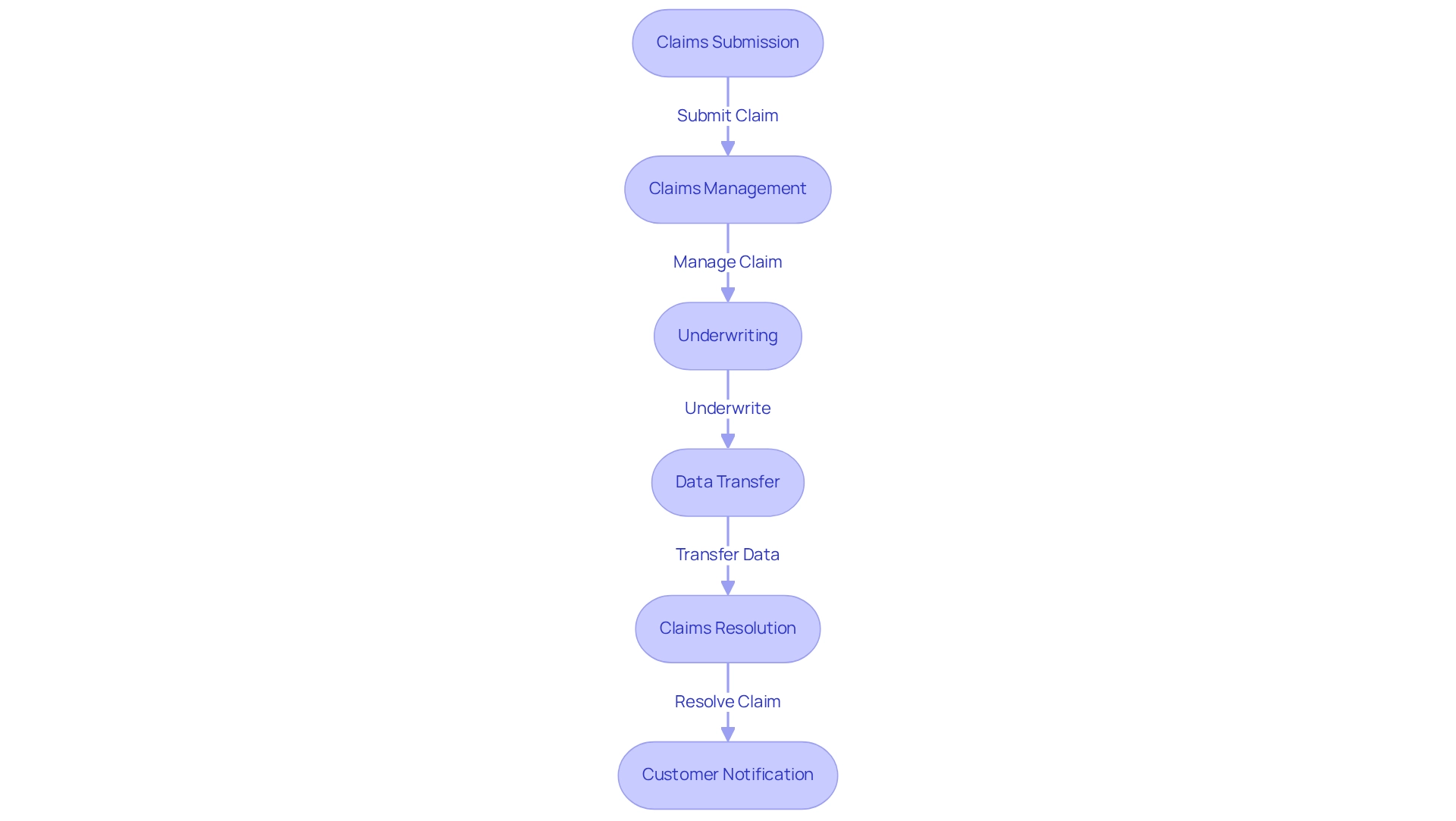
Conclusion
The Enterprise Service Bus (ESB) stands as a pivotal technology across various sectors, catalyzing transformative changes in operational efficiency and service delivery. In banking, we enhance transaction processing by enabling real-time data exchange, significantly improving speed and accuracy while enriching customer experiences. The healthcare sector benefits similarly, as we streamline patient data management through the integration of electronic health records and billing systems, ultimately leading to better patient outcomes.
In retail, we optimize supply chain integration, providing real-time visibility into inventory and order statuses, which boosts operational efficiency and customer satisfaction. Government agencies leverage our ESB for improved inter-agency collaboration, ensuring effective responses during public health crises and enhancing service delivery to citizens. Similarly, telecommunications companies utilize our ESB to facilitate real-time customer engagement, leading to faster response times and a more cohesive customer experience.
The logistics and manufacturing sectors also reap significant benefits, with our ESB enhancing shipment tracking and production line efficiency, respectively. By optimizing workflows and improving data management, we support organizations in adapting to evolving market demands. The energy sector’s smart grid integration and the education sector’s data management further illustrate the versatility and necessity of our ESB technology.
In conclusion, the integration capabilities provided by our ESB are crucial for organizations striving to remain competitive in an increasingly digital landscape. By embracing our ESB, we can streamline operations, enhance customer experiences, and ensure that we are well-prepared to meet future challenges. As the demand for seamless connectivity and real-time data exchange continues to grow, the role of our ESB will only become more vital across all sectors.

